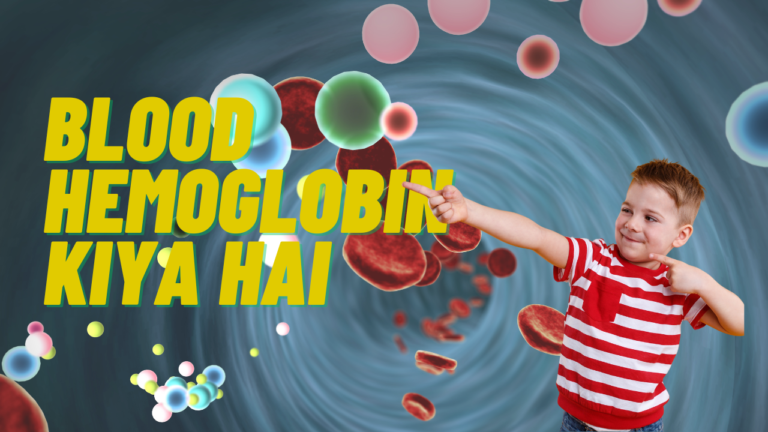Introduction
In the intricate tapestry of the human body, a remarkable substance known as hemoglobin plays a pivotal role. Hemoglobin, often referred to as “Blood ka Himoglobin,” is a complex protein found in red blood cells that binds with oxygen, enabling its transportation from the lungs to various tissues throughout the body. In this insightful journey, we shall unravel the mysteries of hemoglobin, its significance, and its profound impact on human health.
The Essence of Hemoglobin
Hemoglobin: The Oxygen Carrier
Hemoglobin is a true marvel of biological engineering. It acts as a molecular vehicle for oxygen, capturing the life-sustaining gas in the lungs and releasing it to nourish cells and tissues. This process, termed oxygenation, ensures the efficient distribution of oxygen to every nook and cranny of the body, supporting cellular respiration and energy production.
The Hemoglobin Structure
At the heart of hemoglobin’s function lies its unique structure. Comprising four protein chains, known as globulin chains, hemoglobin also cradles a heme group within its folds. This heme group houses an iron atom, which binds with oxygen, giving hemoglobin its characteristic red hue when oxygenated.
The Dance of Oxygen and Hemoglobin
The Oxygen Affinity
Hemoglobin’s relationship with oxygen is a delicate dance influenced by various factors. One of these is the partial pressure of oxygen in the surrounding environment. When oxygen levels are high, such as in the lungs, hemoglobin’s affinity for oxygen increases, facilitating its binding. Conversely, in tissues where oxygen levels are lower, hemoglobin releases its oxygen cargo, ensuring its delivery to cells in need.
Factors Affecting Oxygen Binding
Hemoglobin’s ability to bind with oxygen can be influenced by several factors, including temperature, pH levels, and the presence of other molecules such as carbon dioxide. These intricacies ensure that oxygen release occurs precisely where it’s required, contributing to the body’s finely tuned balance.
The Symphony of Health and Hemoglobin
Vital Role in Overall Health
The significance of hemoglobin extends far beyond its oxygen-carrying prowess. It serves as a critical marker for health, as deviations in hemoglobin levels can indicate underlying medical conditions. For instance, low hemoglobin levels, known as anemia, can result in fatigue, weakness, and other health issues.
Nutrition and Hemoglobin
Proper nutrition is integral to maintaining healthy hemoglobin levels. Nutrients such as iron, vitamin B12, and folate play a crucial role in hemoglobin production. A deficiency in these nutrients can lead to anemia and related complications.
Fascinating FAQs about Hemoglobin
- What is the Ideal Hemoglobin Level? Maintaining an ideal hemoglobin level varies by age, gender, and health status. Generally, normal hemoglobin levels range from 12 to 16 grams per deciliter of blood.
- Can Exercise Affect Hemoglobin Levels? Regular exercise can enhance overall blood circulation and oxygen utilization, indirectly benefiting hemoglobin function.
- How Does Hemoglobin Impact Athletic Performance? Optimal hemoglobin levels contribute to improved oxygen delivery to muscles, potentially enhancing endurance and performance in athletes.
- What Causes Low Hemoglobin Levels? Low hemoglobin levels can result from factors like nutritional deficiencies, chronic diseases, and certain medical conditions.
- Can Hemoglobin Levels Fluctuate? Yes, hemoglobin levels can vary due to factors such as altitude, pregnancy, and health conditions, making periodic check-ups important.
- Is High Hemoglobin Always Beneficial? While high hemoglobin levels can increase oxygen-carrying capacity, excessively elevated levels may strain the heart and circulatory system.
Conclusion
In the symphony of life, “Blood ka Himoglobin” stands as a conductor, orchestrating the delivery of oxygen to sustain the body’s vitality. Through the delicate partnership of hemoglobin and oxygen, the intricate dance of health and well-being unfolds. As we conclude this captivating journey, we’re left with a profound appreciation for the role of hemoglobin—a humble yet monumental player in the grand story of human existence.
Summary: In this exploration of “Blood ka Himoglobin kiya hai?”, we’ve delved into the multifaceted world of hemoglobin. This protein’s role as an oxygen carrier, its intricate structure, and its influence on overall health have been illuminated. Through a series of FAQs, we’ve addressed common inquiries surrounding hemoglobin’s impact on athletic performance, ideal levels, and more. As we bid farewell, we recognize the significance of hemoglobin—a vital component that sustains life.
Keywords: Hemoglobin, Blood ka Himoglobin, oxygen carrier, oxygenation, red blood cells, heme group, protein chains, iron atom, anemia, nutrition, ideal hemoglobin level, exercise, athletic performance, low hemoglobin levels, high hemoglobin levels.




